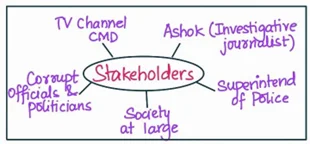Answer:
| Approach:
Introduction
Body
- Options available with Ashok to cope with the situation
- Evaluation of each option identified by Ashok
- Ethical dilemmas faced by Ashok
- The most appropriate option for Ashok to adopt
- Training for police officers posted in districts with rampant illegal stone mining activities
Conclusion
|
Introduction:
The case involves illegal stone mining, corruption, and the pursuit of justice. It follows a determined SP and an investigative journalist as they uncover a nexus of corruption involving the stone mining mafia, officials, and politicians. The TV channel CMD faces an ethical dilemma when presented with the investigative report. This case highlights the challenges in fighting corruption and emphasizes the importance of transparency and ethics in addressing such issues for the betterment of society.

Body:
(a) Options available with Ashok to cope with the situation:
- Publish the investigative story: Ashok can choose to publish the investigative report through electronic media, exposing the nexus between the stone mining mafia, corrupt officials, and politicians.
- Stay silent and comply: Ashok can choose to hand over the investigative report to the TV channel CMD, as advised, and drop the idea of making the story public. In return, he may receive personal benefits such as promotion, pay hike, and loan adjustments.
- Seek external support: Ashok can reach out to external media outlets, regulatory authorities, or investigative agencies to expose the corruption and nexus, ensuring the story gets the attention it deserves.
(b) Evaluation of each option identified by Ashok:
- Publish the investigative story: This option allows for the truth to be exposed to the public, shedding light on the corruption and illicit activities. It upholds the principles of journalism and can contribute to accountability and justice.
- Stay silent and comply: This option compromises journalistic integrity and enables the corrupt individuals to continue their illegal activities without facing consequences. It prioritizes personal benefits over the public interest and may perpetuate a culture of corruption.
- Seek external support: This option provides an avenue for independent investigation and intervention, ensuring that the matter is addressed by external authorities. It may enhance the chances of justice and hold the responsible individuals accountable.
(c) Ethical dilemmas faced by Ashok:
- Upholding journalistic integrity: Ashok faces the dilemma of maintaining his professional duty as an investigative journalist and exposing the truth, or compromising his integrity by suppressing the report for personal gain.
- Balancing personal interests and public interest: Ashok must consider the potential benefits offered by the TV channel CMD against the ethical responsibility to serve the public interest and expose corruption.
(d) The most appropriate option for Ashok to adopt:
- The most appropriate option for Ashok would be to publish the investigative story, exposing the complete nexus of corruption and illicit activities. By doing so, he upholds the principles of journalism, promotes transparency, and contributes to the public’s right to know. This option serves the broader interest of justice and accountability, despite potential personal risks or consequences.
(e) Training for police officers posted in districts with rampant illegal stone mining activities:
- Knowledge of laws and regulations: Police officers should receive comprehensive training on relevant laws and regulations pertaining to illegal mining, environmental protection, and ecological balance.
- Investigation techniques: Training should focus on effective investigation techniques, evidence collection, and intelligence gathering to uncover the networks involved in illegal mining activities.
- Ethical conduct and integrity: Officers should be trained on ethical standards, emphasizing the importance of resisting corruption and the influence of powerful individuals or groups.
- Collaboration and coordination: Training programs should promote interdepartmental collaboration, encouraging police officers to work closely with forest officials, intelligence agencies, and other relevant authorities to combat illegal mining.
- Awareness and sensitization: Officers should be educated about the environmental impact of illegal mining and the need to protect natural resources. This includes raising awareness about the ecological balance and the Supreme Court’s directives regarding mining activities in sensitive areas like the Aravalli Hills.
Conclusion:
Ashok should seek legal counsel and protection to ensure the safety of the evidence and expose the corruption. Police officers in districts with rampant illegal mining activities should receive comprehensive training on anti-corruption measures, environmental law enforcement, conflict resolution, ethics, and safety.
